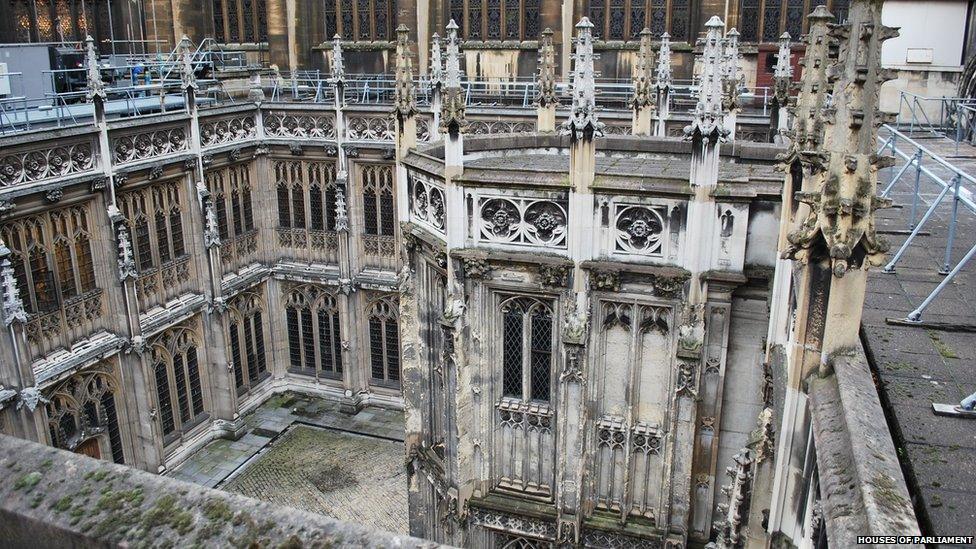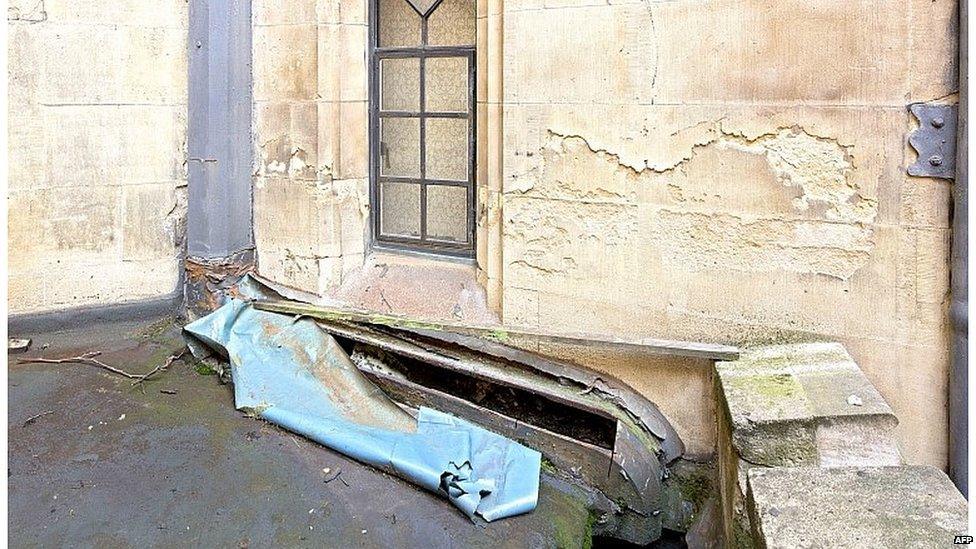MPs are moving out but not until 2025
- Published

MPs have opted to leave the Palace of Westminster when renovations start
It was a pretty close run thing but - rather to its own surprise - the Commons has committed itself to leaving the Victorian Palace of Westminster to make way for a massive "Restoration and Renewal" programme. Mark D'Arcy explains what's going to happens next.
The fact that a well-organised group of MPs orchestrated the move, without ministers taking a lead, and with the government professing careful neutrality about the decision, says something very important about the developing independence of the Commons.
It also says something about the increasing penchant for cross-party working between senior backbenchers.
Look at the key players in the successful amendment which ensured that parliamentarians will move out.
Meg Hillier the Labour chair of the powerful Public Accounts Committee, her Conservative deputy Sir Geoffrey Clifton-Brown and Sir Paul Beresford, the Conservative ex-minister who now chairs the Commons Administration Committee.
Cheapest answer
And there are the young Conservative guns Tom Tugendhat and Johnny Mercer as well as the DUP's Ian Paisley.
They sent out a letter drawing MPs' attention to the PAC's report recommending moving out as the cheapest answer to the crumbling state of the building.
The whole effort was quite a coup for the PAC and a move that would have been almost unimaginable a few years ago, when the instincts of MPs were more subservient and the response of the government would probably have been more dismissive.
It has not quite reached the level of buyers' remorse but the morning after the vote to move out, many MPs were a little nervous about the probable backlash.
Fire alarms sixty times a month
After the Grenfell Tower tragedy, with every public service clamouring for more funding, it is not a good look for Parliament to be spending billions "on itself". The trouble is that the building burning down - the fire alarms go off about 60 times a month I'm told - or being hit by a blackout or a sewage flood is not a good look either.
Perhaps it was the speech of Sir Paul Beresford, a hard-headed ex-leader of the famously frugal and Thatcherite Wandsworth Council, which swung crucial Conservative votes to back leaving?
The renovation won't happen soon. The Commons leader Andrea Leadsom told MPs 2025 at the earliest. First, much more detailed investigation and planning will have to be completed, and a new chamber and offices will have to be constructed on the site of Richmond House, the former Department of Health building, just to the north of the current Parliamentary offices, on Whitehall.
Incidentally, it is worth name-checking another key player in these events. The Health Secretary, Jeremy Hunt agreed to relocate his department, against the opposition of his officials, so that Richmond House would be available to Parliament.
It is now clear that much of the existing building will have to be knocked down to allow the relocation and MPs will not move out of the Victorian part of their home, until the new space is ready.

Until renovation gets under way it'll be patched and mended
Meanwhile the corridors of the old building will be patrolled to guard against fire breaking out and the existing facilities will be continually patched and mended to keep them going. That is, in itself, very expensive. No-one in the know believes it is impossible that the services in the old building will fail before that moment. The nightmare scenario is that the fuses go pop in the middle of some major occasion like a State Opening.
As for the costs, the £3.6 billion figure for restoration in the absence of the parliamentarians (it is much more if they stay in situ) is carefully referred to by officials as "indicative". This delicate word conceals a multitude of caveats. There are "known unknowns" like the question of how much it will cost to fit proper access for disabled people into the current building, or the cost of asbestos removal and fire prevention. Or the cost of the improvements to the facilities that might be proposed.
What's under the floorboards?
Then there are the "unknown unknowns". What, oh what, will be found when the floorboards come up and the panelling is taken down, to reveal the state of the structure beneath?
The next step will be for the Lords to debate the proposal. No-one is quite sure what would happen if they voted to stay, when MPs have agreed to move out. But assuming they, too, sign up a Bill would then be put before Parliament, to set up an Olympics-style delivery authority to take charge of the process.
Bills can be amended and already markers are going down. Keep an eye on the Chair of the Public Administration and Constitutional Affairs Committee, the Conseravtive Bernard Jenkin, who is keen to ensure the Authority will not be locked into a decant-based strategy, if other options seem more sensible.
Good gargoyles required
Meanwhile Labour's Chris Bryant wants a strategy to train hundreds apprentices in the kind of skills that will be required to deliver R&R - stonemasons who can produce a good gargoyle, carpenters who can reproduce the elaborate Victorian woodwork, and so on.
MPs have been promised that this legislation will guarantee that they do return to their ancient home when the work is done. The wording of that guarantee will be carefully examined.
The final question is how the building might be improved. Several, often rather ugly, layers of additions might be scraped away - the rooftop cabins where some MPs have their offices might go, for example.
Some of the internal courtyards might be roofed over, to provide new debating chambers, and better, and more secure, arrangements could be made for the thousands of visitors who flow through Parliament every day.
If any of these things were to be done, that would be the moment to do them.